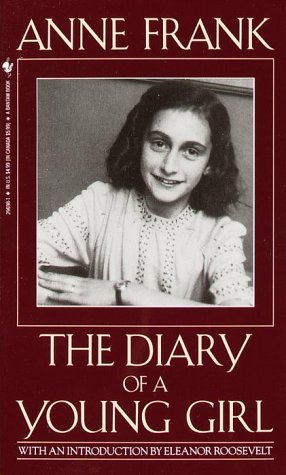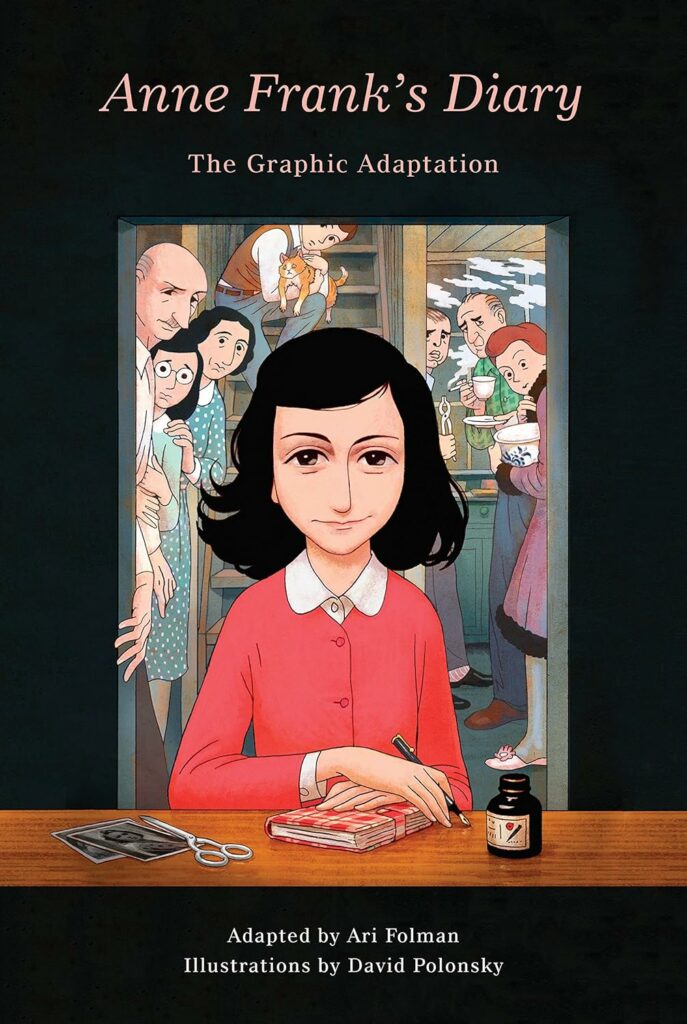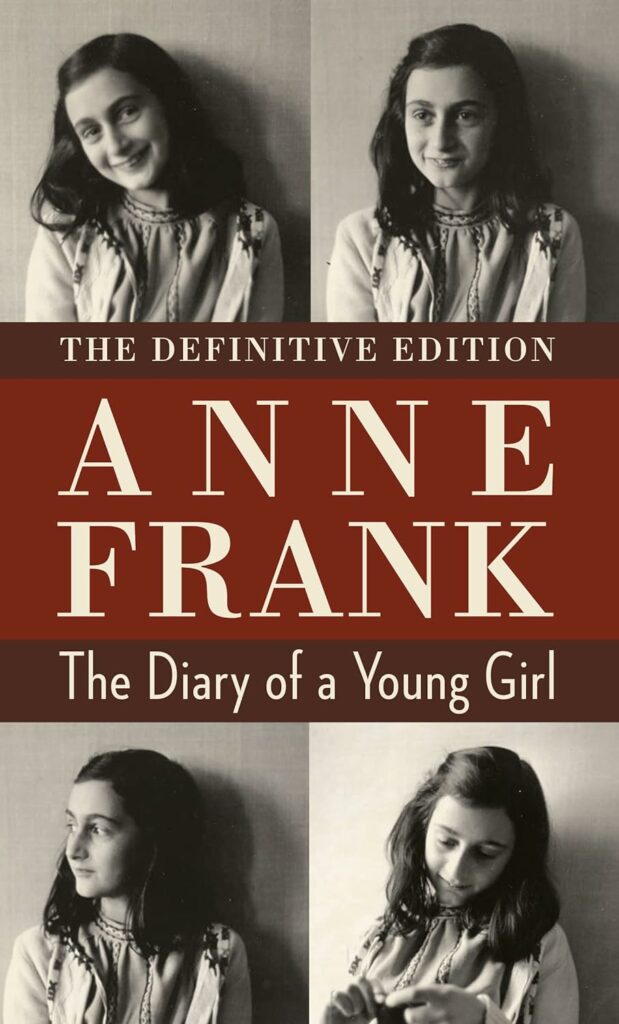A lengthy post in which Betsy seeks to answer some of the many questions she and the RR team have received over the past several years.
The Diary of Anne Frank: Some Background

Most adults are familiar with Anne Frank: the young Jewish woman who kept a diary throughout her family’s years of hiding from the Nazis. After Anne’s family was betrayed and captured, Anne’s diary was found in her family’s hiding spot by some women who had cared for the family during their hiding. Anne’s father (the only surviving member of the family) edited the diary and published it for family and friends. Later, after readers urged him to do so, he had the diary officially published in 1947. The first English edition sold in the United States in 1952. Millions have read that version, and, for many years, Anne Frank: The Diary of a Young Girl was one of the primary ways junior high students really grappled with the Holocaust and the personal toll of World War II.
Fast forward a few decades and The Diary of a Young Girl: The Definitive Edition by Anne Frank was published (English version in 1995). This definitive edition includes “previously unpublished material” and is, presumably, more faithful to Anne’s original diary. What was left out in the first version?
Anne Frank’s Adolescence
Before we dwell on what was left out of the first published edition, what was included in the “definitive” edition, and whether those omissions or inclusions are good or bad, let’s first remind ourselves who this young woman was and how old she was. When the diary starts (June 12, 1942), Anne has just turned thirteen. Anne writes in her diary faithfully for just over two years (the final entry is August 4, 1944); she is fifteen when the family is captured. A few notable facts of which I need hardly remind my readers: Life in Nazi-occupied Holland for a Jewish family was a horrific experience in every way, fraught with emotional upheaval, physical deprivation and danger, and constant fear. Second, young teen girls are notoriously emotional (and curious!) as they grapple with hormonal changes during puberty and the general tumult adolescence brings. (Incidentally, boys are emotional and curious during puberty as well, but they show it differently.)
Why are these facts important? We read The Diary of Anne Frank from a completely different viewpoint than Anne herself if we are reading it as Americans in 2023, particularly if we are adult readers. If we allow ourselves to step back in time, into our own young teenage selves, we might find Anne’s diary both more compelling and less problematic. Why?
Anne didn’t set out to write her diary as a “Statement of Young Womanhood and Self-Actualization.” Yes, she’s very outspoken and forthright about all subjects. Yes, she’s a strong young woman with definite opinions. And yes, she did hope to be published someday. But the diary is more a record of a young woman struggling through adolescence in a horrific time and place than it is an agenda-driven book that is hoping to normalize all struggles and sin. It’s simply a forthright account of a young woman’s feelings and experiences.
Did you keep a diary when you were that age? I did, and I’m very glad it hasn’t survived! Most of us would be mortified to go back and read our thoughts from that time period. Thankfully, most of us have matured, and, indeed, we see Anne herself maturing over the course of the two years, particularly in regards to her mother.
What Are the Differences in the Two Diary Editions?
Full disclosure: I haven’t read the Definitive Edition closely all the way through. I did quite a bit of research and compared multiple diary entries side-by-side (after closely re-reading the first version); then I quickly skimmed the definitive edition.
The three biggest changes between the two editions relate to the following:
- More detail in the Definitive Edition. And by more, I mean quite a bit of tedious detail: prices, multiple names of friends and acquaintances, and so forth. There’s a significant amount of detail in the first version already. I don’t think the extra detail is essential to the reading experience.
- Anne’s relationship to her mother (or, more accurately, her feelings toward her mother): Anne has a stormy relationship with her mother, at least in her own mind, constantly feeling that her mother doesn’t love her, that her father does’t really love her mother, and that no one understands her (does this sound like any other young teen girls you know?). This is present in the first edition, but far more pronounced in the Definitive Edition.
- Puberty and sexuality: Anne is very frank about the changes her own body is going through, her awakening interest in sexuality, and the information she knows and/or discovers. This is fairly common for those going through this same life stage, but the earlier edition left out most of the specific information. As such, the earlier edition is much more middle school friendly, and the Definitive Edition is best reserved for high school. See below for more specifics.
Which Edition Should You Read (or Assign Your Students)?
That depends.
I’m not trying to be vague. It really does depend on several key factors: What age is the target audience/reader? How mature is that audience? What are your goals for this book? Is this the best book for your purpose? Not every book needs a “goal” or “purpose,” but this book is often read as an associated read for a study of the Holocaust. If your academic purpose is for your students to really get into the mind of someone suffering through that atrocity, then the first edition is by far the better choice, assuming The Diary of Anne Frank is the way to go in the first place. Because so much of the more titillating material is left out, more emphasis is given to the deprivations and dire straits the family is in due to Hitler’s regime.

If your purpose is for students to experience life through the eyes of someone who lived 80 years ago, but to whom we can still relate because the general human experience is the same, then either version might be a choice, bearing in mind the more mature content.
There is at least one graphic novel version of Anne’s story; I read Anne Frank’s Diary: the Graphic Adaptation, adapted by Ari Dolman and illustrated by David Polonsky. This version draws heavily from the Definitive Edition and includes many of the parts that were cut for the earlier edition. In addition, since it is a graphic novel, there are plenty of associated images. This might be an acceptable choice for a high school audience if the purpose is to give students a broad overview of the time period and the human experience in the midst of trauma. But given the images in this version, I’d recommend it only with caution, and I would absolutely recommend the teacher/adult read it first.
Considerations for the Different Editions
And now we come to the crux of the matter, the reason our readers have reached out to us for our opinion over the past few years. I’ll be as specific as I think helpful; ultimately, you will need to make your own decision, and I recommend (always!) reading a given title before assigning it to a group of students. You know your students best, and you will be better able to make a decision about a particular title than an outsider. Parents: if you have questions regarding the information below, I invite you to read the book first before approaching a teacher or school.
Note: the following information is not be suitable for young readers.

Puberty and Associated Issues: As my parents’ generation might say, “Anne becomes a woman” during these two years. Both editions (and the graphic novel version) include mention of Anne’s period and some of her related thoughts. Both editions (and the graphic novel version) include some of Anne’s questions related to her changing body and the bodies of her friends. The Definitive Edition includes more of Anne’s musings over her changing body and references to her period, but both versions do include this sort of content.
In particular, the entry for January 6, 1944, includes references to her curiosity and interest in one of her friends and in the female body in general. Because the two editions are both English translations of the original, the wording is slightly different although the content is largely the same. One *could* read this entry as that of a burgeoning lesbian. And that, indeed, is the way many in the year 2023 will choose to read it. I do not believe that’s the point of this entry. I think this is simply the honest curiosity and tempestuousness associated with a young woman whose body is rapidly changing, alongside those of her friends. Remember: at this point, Anne has been in hiding for 18 months, she has no friends, and she doesn’t even have the standard, middle school sex ed class. For that matter, she doesn’t have Google, a telephone, or even a library from which to get her information. Most of us would much rather have discussed these questions and curiosities with our close friends of the same gender than with our parents. It’s no wonder Anne wishes for a girl friend.
Part of the issue with today’s transgender movement is that this normal curiosity and wonder over the human body has been pounced upon: a young woman no sooner mentions something like this (or thinks it in her head) than society declares her a lesbian or gender queer or something else on the LGBTQ+ spectrum. Curiosity is not identity. We would do far better to engage with our young people, answering their questions, recognizing that curiosity in puberty-related and sexuality-related issues is normal, and directing them to a biblical view of sexuality rather than automatically assuming this is a person’s lifelong identity.
Of particular note is that the graphic novel adaptation includes a full-page image of stylized nude female statues with this diary entry. It reinforces the contemporary fixation on identity as compared with the text-only versions.
Sexuality: Again, remember that Anne has no library, no friends, no Google, no way to get her many questions answered other than the few books her family has brought with them and the other seven people in the Annexe. How many of us would go to our parents with our questions when we were 14? Would you feel comfortable sitting down with one or the other of your parents as a young teen and discussing human genitalia? Sexuality? Most of us would far rather discuss these sorts of questions with our peers. And that is what Anne does. It just so happens that her only peer, other than her sister, is a young man named Peter.
Anne, Peter, and occasionally Anne’s sister, Margot, end up discussing various human anatomy-related questions, beginning with the resident cat. Peter proves that the cat is a male, despite Anne’s original belief that the cat was pregnant. The graphic novel takes this one step further, supplying a key word for male anatomy. Later, Anne instructs Peter in the finer points of female anatomy in the Definitive Edition (diary entry from Friday, March 24, 1944). The graphic novel includes an image of Anne using an overhead projector with a part of female anatomy displayed; at a quick glance, this projected image doesn’t look like much, but when viewed alongside the text, it’s fairly graphic.
In both editions, Anne and Peter kiss and Anne has plenty of thoughts about Peter and whether she is being too forward with him (or allowing him to be too forward with her). The Definitive Edition includes a section in which she decides “losing your virtue doesn’t matter” under the right circumstances (Thursday, March 2, 1944). Both editions imply that she is chafing under their circumstances and that both sets of parents disapprove of the time she and Peter spend together in Peter’s room; the diary implies that not much more than kissing is happening (unless there’s a later entry I missed in the Definitive Edition that says otherwise). Obviously, there’s nowhere in public for Anne and Peter to go on dates; just as obvious, though, is that two young people in love are playing with fire to spend lots of unchaperoned time in a person’s bedroom.
Alternatives to The Diary of Anne Frank
Should you read The Diary of Anne Frank? That is up to you! If you choose not to, please do not do so in a spirit of “this book should be banned.” It’s a modern classic and certainly has its place, particularly the earlier edition. However, we must also remember that when the diary was first published, there simply wasn’t much other material on the Holocaust for young people to read. This was a standard read for decades partly because it’s a fascinating read, but partly because it was the only read.
Today, we have many well-written alternatives. Here are my top two alternatives, if Anne Frank’s Diary is not the right fit for your situation:
- The Hiding Place by Corrie Ten Boom: Anne Frank’s diary is fairly secular. Corrie Ten Boom’s account is saturated with her Christian faith and is a beautiful testimony of a life. Additionally, the conditions in the camp come alive in The Hiding Place in way they can’t in The Diary of Anne Frank. There’s a Young Readers Version that isn’t a bad option for middle school. The original is a far better book but it better suited for high school due to its heavier content and some frank discussions about sexuality. This is my top recommendation.
- Number the Stars by Lois Lowry: historical fiction, but a lovely, poignant read for upper elementary students. Number the Stars is a terrific introduction to the idea of the Holocaust.
Or, you may browse our reviews of books set during (or about) World War II!
Have you read The Diary of Anne Frank recently? With your students? What do you think?
Stay Up to Date!
Get the information you need to make wise choices about books for your children and teens.
Our weekly newsletter includes our latest reviews, related links from around the web, a featured book list, book trivia, and more. We never sell your information. You may unsubscribe at any time.
Support our writers and help keep Redeemed Reader ad-free by joining the Redeemed Reader Fellowship.
Stay Up to Date!
Get the information you need to make wise choices about books for your children and teens.
Our weekly newsletter includes our latest reviews, related links from around the web, a featured book list, book trivia, and more. We never sell your information. You may unsubscribe at any time.
We'd love to hear from you!
Our comments are now limited to our members (both Silver and Golden Key). Members, you just need to log in with your normal log-in credentials!
Not a member yet? You can join the Silver Key ($2.99/month) for a free 2-week trial. Cancel at any time. Find out more about membership here.
3 Comments
Leave a Comment
You must be logged in to post a comment.




Thank you so much for taking the time to do this research. This is such a thoughtful and helpful piece. I have been reading your website for a few years now and continue to be impressed by your helpful perspective. Thank you!
I’m so glad you found it helpful!
Thank you so much for this review! The moms in my kids’ book club selected Diary of a Young Girl for our kids to read (middle school) and I was surprised to find the graphic nature of some of the journal entries in the book I bought; I read the book in eighth grade and remembered none of it (probably because I read the earlier version). I decided to get the book on Kindle instead and read it aloud with my kids so that I could skip over parts, depending on how I think my kids could handle the material. So far we’re enjoying hearing from Anne, and we’re finding her thoughts and feelings are not so different from my kids’ own adolescent emotions.